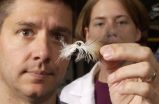(Press-News.org) Boston, Ma – Fainting, or syncope, is quite common. About 50% of people will experience fainting at some point during their lifetime. The most common type of fainting is vasovagal syncope (VVS) that is caused by a sudden drop in blood pressure resulting in reduced blood flow to the brain. VVS can occur in healthy people due to inappropriate cardiovascular responses to certain behavioral or emotional triggers such as fear, needle prick or even standing up. VVS has a daily pattern with more occurrences during the morning. This daily pattern is possibly due to the daily distribution of behavioral and emotional stimuli or perhaps due to influences from the internal circadian system, or 'body clock'. In a new study, researchers at Brigham and Women's Hospital (BWH) provide strong evidence that the circadian system may contribute to the daily pattern of VVS via its influences on physiological responses to changes in body posture. These findings are published on March 8, 2011 in the journal Circulation.
Lead study author Kun Hu, PhD, of the Division of Sleep Medicine at BWH said that "the susceptibility to VVS is probably present in all healthy humans. Fainting can cause an individual to fall which can result in severe trauma, including skull and limb bone fractures. Recurrent VVS can also affect quality of life due to reduced activities and social adjustment. Understanding the causes of VVS is important for diagnosis, prevention and treatment of people with a history of recurrent VVS".
In this study, repeated tilt-table tests were used to determine the susceptibility to VVS across the day and night in twelve healthy participants who stayed in a controlled laboratory environment for almost 2 weeks. To measure the influence of the internal body clock on VVS while controlling for other factors including the sleep/wake cycle, meals and the environment, the researchers scheduled all behaviors of participants while they lived on a recurring 20-hour "day" (with 6.7 hours scheduled for sleep and 13.3 hours for wake). The study was performed in dim light so that the internal body clock still oscillated with an approximate 24-hour period. Core body temperature was measured throughout to indicate the times of the internal body clock. To stop the participants from actually fainting, signs of imminent VVS (presyncope) were closely monitored and tilt-table tests were immediately aborted whenever there were notable symptoms of nausea, dry mouth, dizziness, or low blood pressure or rapidly falling blood pressure.
The researchers found that the vulnerability to presyncope has a strong connection to the internal body clock, with susceptibility nine times higher at the circadian times between 10:30 PM and 10:30 AM compared to between 10:30 AM through 10:30 PM. The highest risk for presyncope occurred at the circadian time corresponding to 4:30 AM. "This vulnerable period may have relevance to individuals who remain awake or wake up frequently during the night, such as shift workers, parents feeding their infants and elderly people with increased nocturia or insomnia. These people may be at higher risk for syncope due to their postural changes during the night" said one of the investigators, Dr. Steven Shea of the Division of Sleep Medicine at BWH.
In addition, this study highlights the importance of performing tilt-table tests at similar circadian times when comparing responses of different individuals or the same person before and after treatments for syncope. The results also suggest that a higher sensitivity may be achieved by performing tilt-table testing during early morning hours or the night.
###
The research was funded by grants from the National Institutes of Health and the Harvard Catalyst.
Brigham and Women's Hospital (BWH) is a 793-bed nonprofit teaching affiliate of Harvard Medical School and a founding member of Partners HealthCare, an integrated health care delivery network. BWH is the home of the Carl J. and Ruth Shapiro Cardiovascular Center, the most advanced center of its kind. BWH is committed to excellence in patient care with expertise in virtually every specialty of medicine and surgery. The BWH medical preeminence dates back to 1832, and today that rich history in clinical care is coupled with its national leadership in quality improvement and patient safety initiatives and its dedication to educating and training the next generation of health care professionals. Through investigation and discovery conducted at its Biomedical Research Institute (BRI), BWH is an international leader in basic, clinical and translational research on human diseases, involving more than 900 physician-investigators and renowned biomedical scientists and faculty supported by more than $ 537 M in funding. BWH is also home to major landmark epidemiologic population studies, including the Nurses' and Physicians' Health Studies and the Women's Health Initiative. For more information about BWH, please visit www.brighamandwomens.org.
Body's clock may lead to increased risk for fainting during the nighttime
2011-03-08
ELSE PRESS RELEASES FROM THIS DATE:
Clinical observation leads to lung cancer discovery
2011-03-08
AURORA, Colo. (March 7, 2011) - A discovery at University of Colorado Cancer Center shows testing lung cancer on a molecular level can produce new insights into this deadly disease.
Cancer Center member D. Ross Camidge, MD, PhD, director of the thoracic oncology clinical program at University of Colorado Hospital (UCH), turned a chance clinical observation into a new field of discovery in lung cancer.
In October 2010, Camidge and colleagues published a study in the New England Journal of Medicine showing more than half of patients with a specific kind of lung cancer ...
Research demonstrates relationship of Texas coastal prairie-pothole wetlands to Galveston Bay
2011-03-08
New research reveals vast tracts of wetlands along the upper Gulf Coast are more hydrologically connected to Galveston Bay and other waters of the U.S. than previously thought, suggesting immediate implications for how they are preserved, managed and regulated, according to Texas AgriLife scientists.
"Loss of wetlands closer to traditional navigable waters must be mitigated under the Clean Water Act by creating new wetlands, or preferably by protecting and restoring similar existing wetlands," said Dr. John Jacob, Texas AgriLife Extension Service environmental quality ...
USC California superstorm would be costliest US disaster
2011-03-08
A hurricane-like superstorm expected to hit California once every 200 years would cause devastation to the state's businesses unheard of even in the Great Recession, a USC economist warns.
Researchers estimate the total property damage and business interruption costs of the massive rainstorm would be nearly $1 trillion.
USC research professor Adam Rose calculated that the lost production of goods and services alone would be $627 billion of the total over five years. Rose, a professor with the USC School of Policy, Planning, and Development, also is the coordinator for ...
Helicobacter pylori infection linked to decreased iron levels in otherwise healthy children, according to research at UTHealth
2011-03-08
HOUSTON-(March 7, 2011)- Children without previous iron deficiencies or anemia who remained infected with Helicobacter pylori (H. pylori) had significantly lower levels of iron compared to children who had the infection eradicated, according to researchers at The University of Texas Health Science Center at Houston (UTHealth).
"Half of the world's population is infected with H. pylori and most of the individuals are asymptomatically infected, according to several surveys," said Victor Cardenas, M.D., Ph.D., lead investigator of the study and associate professor of epidemiology ...
Evolution drives many plants and animals to be bigger, faster
2011-03-08
Durham, NC —For the vast majority of plants and animals, the 'bigger is better' view of evolution may not be far off the mark, says a new broad-scale study of natural selection. Organisms with bigger bodies or faster growth rates tend to live longer, mate more and produce more offspring, whether they are deer or damselflies, the authors report.
Researchers working at the National Evolutionary Synthesis Center compiled and reviewed nearly 150 published estimates of natural selection, representing more than 100 species of birds, lizards, snakes, insects and plants. The ...
People would rather let bad things happen than cause them, especially if someone is watching
2011-03-08
People are more comfortable committing sins of omission than commission—letting bad things happen rather than actively causing something bad. A new study published in Psychological Science, a journal of the Association for Psychological Science, suggests that this is because they know other people will think worse of them if they do something bad than if they let something bad happen.
"Omissions and commissions come up relatively frequently in everyday life, and we sometimes puzzle over them," says moral psychologist Peter DeScioli of Brandeis University, who conducted ...
Popular drugs for common male health problems can affect their sexual health
2011-03-08
A new study published in The Journal of Sexual Medicine reveals that, for the first time, 5a-reductase inhibitors commonly used to treat urinary problems in patients with benign prostatic hyperplasia (BPH) and found in popular medications to treat hair loss, can produce, persistent erectile dysfunction (ED), depression and loss of libido, even after the medication has been discontinued.
Researchers led by Abdulmaged M. Traish, MBA, PhD, of Boston University School of Medicine, examined data reported in various clinical studies from the available literature concerning ...
Stretchable balloon electronics get to the heart of cardiac medicine
2011-03-08
CHAMPAIGN, Ill. — Cardiologists may soon be able to place sensitive electronics inside their patients' hearts with minimal invasiveness, enabling more sophisticated and efficient diagnosis and treatment of arrhythmias.
A team of materials scientists, mechanical and electrical engineers, and physicians has successfully integrated stretchable electronics technology with standard endocardial balloon catheters. Led by John A. Rogers, the Lee J. Flory-Founder Chair in Engineering at Illinois, the team published its work in the March 6 online edition of Nature Materials.
The ...
New perspective diminishes racial bias in pain treatment
2011-03-08
MADISON — Years of research show black patients getting less treatment in the American health care system than their white counterparts, but a new study suggests that a quick dose of empathy helps close racial gaps in pain treatment.
College students and nurses went to greater lengths to ease the pain of members of their own race in a study led by Brian Drwecki, a psychology graduate student at the University of Wisconsin-Madison.
"I want to be very clear about this: We're not saying health care professionals are racist," Drwecki says. "This is not racism. Racism is ...
DNA better than eyes when counting endangered species
2011-03-08
WEST LAFAYETTE, Ind. - Using genetic methods to count endangered eagles, a group of scientists showed that traditional counting methods can lead to significantly incorrect totals that they believe could adversely affect conservation efforts.
Andrew DeWoody, a professor of genetics at Purdue University; Jamie Ivy, population manager at the San Diego Zoo; and Todd Katzner, a research assistant professor at the University of West Virginia, found that visual counts of imperial and white-tailed sea eagles in the Narzum National Nature Reserve of Kazakhstan significantly underestimated ...

